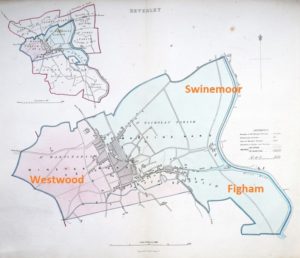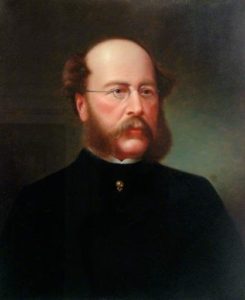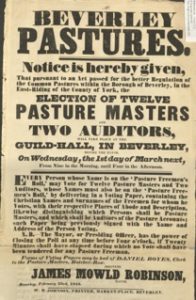In the 1830s, towns in England and Wales went through a series of dramatic changes of governance. Two were driven by famous pieces of legislation: the 1832 Reform Act, which reconstructed urban Parliamentary franchises; and the 1835 Municipal Corporations Act, which recast civic government. The third was the significant reorganisation of civic space and property rights, which followed as an unintended consequence of these Acts. My recent Social History article shows that by changing who was represented, and how civic government was constructed in over 100 towns and boroughs, these acts restructured freemen’s (and their widows’) rights to corporate property, sometimes extinguishing rights to urban lands that had been possessed in common for centuries, and sometimes recasting the complicated political relationships that had grown up around these rights.[1]
Contested Concepts of Common Land
Urban common lands and resources had been nibbled away at for centuries, but the upheaval in corporate rights, privileges, and electorates made their fate a public issue in the 1830s. These debates link to a long-standing disagreement about ‘Common-Pool Resources’ (CPRs) between advocates of New Institutional Economics and those we can call ‘historicists’. The former favour the model created by Nobel-laureate economist Elinor Ostrom, which explains the long-term preservation of common resources as the most rational economic choice for users of a shared resource.[2] This has superseded Garrett Hardin’s famous pessimistic ecological concept ‘The Tragedy of the Commons’, in which unregulated shared resource were doomed to a destructive free-for-all by unrestrained individualism.[3]
Ostrom related this hypothesis to a series of ‘real-world’ examples, and formulated ‘rules’ by which CPRs can be preserved, which has interested developmental economists, ecologists, and social anthropologists, as well as community activists.[4] It has also encouraged historians to apply it to historical case-studies, stimulating comparative research into the management and fates of commons across Europe.[5] However, Sheilagh Ogilvie has argued forcefully that New Institutional Economics ignores the social disposition of power. In her view, most economic institutions in early modern Europe were largely incapable of delivering resources equitably to their users, and ran on extremely unequal distributions of power (in relation to differences in age, gender, ethnicity, religion, status, political affiliation, or personal connections).[6] Ogilvie also questions whether we can ever separate the governance of economic institutions from the wider power structures of the societies in which they (and their CPRs) are located.
These issues of power and external interests frequently converged because on most commons in the British Isles (and in many parts of France and northern Europe) the users of commons were generally not the owners of the property on which they exercised these rights (who were often manorial lords).[7] These conflicts of interests did not exist where commons-users were the legal owners of their shared resource. Collective ownership by members of the commune was common parts of Europe, but what about England?
Common Land, Political Influence and Corruption
The short answer is ‘yes’. As long ago as 1898 F. W. Maitland found in the Middle Ages there had been what he termed ‘burgensic users in common’ in English and Welsh towns, whose membership of the corporate body gave them a share of its corporately-owned property (including common lands).[8] These included freemen in long-established ‘shire-boroughs’, such as York, Lincoln, Nottingham, Leicester, Derby, Huntingdon, Cambridge, Northampton, Bedford, Hertford, Oxford, Worcester, Gloucester, Stafford, Chester, and major towns such as Newcastle-upon-Tyne, Preston, Coventry, Beverley, Norwich, Colchester and Southampton.[9]
Obviously, these corporate use-rights bound up in other political rights and relationships, notably the franchise in municipal and Parliamentary elections. The 1832 Reform Act divorced the parliamentary franchise from existing rights of civic freedom, by giving the vote to all ‘£10 householders’. The 1835 Municipal Corporations Act gave all resident ratepayers the right to elect councillors. Curiously, though, neither piece of legislation explicitly abolished the pre-existing rights of civic freedom with rights of common attached. Some boroughs continued to reserve access to these resources to the ‘old’ freemen but in most, this change accelerated the enclosure of such lands (to remove the anomaly) or their conversion into public parks (which benefitted all ratepayers).[10]
The Example of Beverley, East Yorkshire, 1835-70
However, sometimes the reforms of the 1830s created commons with management systems that epitomised Ostrom’s transparent model. The best example is Beverley in East Yorkshire, where management of the town’s three common pastures (Westwood, Hurn and Figham, totalling 1,217 acres) was transferred to 12 pasture-masters, elected by the qualified freemen (rather than the newly enfranchised borough ratepayers).[11] These rights remained economically and politically important in Beverley, because they provided access to land for 722 entitled freemen and their widows within the borough (38 per cent of all households in the 1841 Census). Elections of pasture-masters were annual, public, and hotly contested. Byelaws for the management of the commons were also posted up each year, and were enforced through the application of sanctions, including legal action against infractions.
The problem was that these rights did not exist within a purely ‘economic’ space. Beverley’s freemen lived in an increasingly competitive and corrupt political environment. The town was divided sharply (but relatively equally) between Liberals and Conservatives. Fierce contests had encouraged electoral bribery, but this became endemic after 1855, with the advent of Conservative MP Major (later Sir) Henry Edwards, and the machinations of his unofficial local election agent, William Smales Wreghitt. Edwards’ representatives brought bags of sovereigns into Beverley, which Wreghitt and his agents paid out openly in the town’s inns to large numbers of qualified voters and freemen. Investigations by an 1870 Royal Commission estimated that approximately 800 of the 1,100 voters ‘were open to bribery and other corrupt influences’.[12]
Wreghitt also funnelled money to voters through the ‘Beverley Working Men’s Conservative Association’, while Edwards invested in a struggling local iron foundry, to create another vehicle to bribe employees and suppliers. From 1858, Wreghitt rigged borough council elections, to gain control over the Parliamentary election machinery. He also influenced the annual elections for the pasture-masters. He paid out £60 for the pasture-masters’ election in 1861 to oil the political wheels, even though they were all Conservatives and there was no contest!
However, pasture-masters could not really influence who had common rights, so why did Wreghitt bother to subvert this body? The answer was their control over funds for poor freemen and widows who could not afford animals, or whose animals died. These had increased massively in 1854 when Robert Walker had left £1,400 in railway shares to the pasture-masters. This innocent bequest was added to the sums used to bribe voters. Between 1860 and 1868, recipients voted Conservative twice as often as they voted Liberal in the election following receipt of the money. Local freeman James Anderson summed up the sentiments of many voters. When Commissioners asked why, as a Liberal, Anderson had voted Conservative, he replied unabashed, ‘Because they told me they were giving money’. Instead of feeling ashamed, he admitted he ‘felt rather pleased; it looked very nice, 17s 6d’. Better, perhaps, to take the money and leave the running of the borough to Edwards and Wreghitt.
Consequently, after 1870 Beverley lost the right to elect MPs, because (as an earlier judge put it) ‘the elective body was so corrupt that no election made by them could be valid’. Yet, the Town Moors and their management by the pasture-masters remained intact.
Common Lands and the Politics of Access
Could the pasture-masters still exist as an ‘efficient’ CPR, unimpeded in an economic ‘space’ detached from the political maelstrom within the borough? Certainly, until it was swallowed by Wreghitt’s political ‘machine’, management of the commons was independent and largely self-regulating because it was based on transparent ownership, generally effective regulation, and the relatively equitable distribution of use-rights. However, it was also part of those wider power structures, and its workings did not challenge the social, economic, or political interests of established local power groupings.
As Ogilvie argues, economic institutions existed in political ‘space’, because the management system reflected differentials of authority, status, and power. It is easiest to see these in the historical record when power is challenged, but the challenge for historians or economists is how to interpret their operation the rest of the time, when they functioned routinely and un-controversially. Does this relative silence represent an economic equilibrium, in which collective utility is able to hold competitive impulses in check? Or does it reflect political inertia, where the power of ruling cliques was just too difficult to challenge? Beverley’s Town Moors are an extreme example, but the wider history of urban commons suggests that although they often enjoyed extended periods of self-regulating economic equilibrium, they could be unstable in the long-term, and needed support from favourable (unequal) property regimes and (self-interested) power structures.
Henry French is Professor of History at the University of Exeter. His work encompasses histories of landownership, masculinity, gender identity and class in England from c.1500 onwards. You can read Henry’s full exploration of the fate of common land in nineteenth-century British urban and political life in his Social History 49.2 article.
References
[1] BPP Commons Sessional Papers 1870, lv, 448 ‘Return of all Boroughs and Cities in the United Kingdom possessing Common or other lands.
[2] E. Ostrom, Governing the Commons: the evolution of institutions for collective action (Cambridge University Press: Cambridge, 1990).
[3] G. Hardin, ‘The tragedy of the commons’, Science, 162 (1968), 1243-48.
[4] D. Wall, The Commons in History. Culture, Conflict, and Ecology (MIT Press: Cambridge, Mass. & London, 2014).
[5] N. Vivier, Proprieté collective et identité communale: des biens communaux en France 1750-1914 (Publications de la Sorbonne: Paris, 1998); M. De Moor, L. Shaw-Taylor & P. Warde (eds), The management of common land in north west Europe, c. 1500-1850 (Brepols: Turnhout, 2002); J. M. Lana Berasain, ‘From equilibrium to equity. The survival of commons in the Ebro Basin: Navara from the 15th to the 20th centuries’, International Journal of the Commons 2 (2008), 162-91; T. De Moor, The Dilemma of the Commoners. Understanding the use of common-pool resources in long-term perspective (Cambridge University Press: Cambridge, 2015); M. De Keyzer, Inclusive commons and the sustainability of peasant communities in the medieval Low Countries (Routledge: New York & Abingdon, 2018); N. Grüne, J. Hübner & G. Siegl (eds), ‘Rural Commons. Collective use of resources in the European agrarian economy’, Jahrbuch für Geschichte des ländlichen Raumes/Rural History Yearbook 12 (2016).
[6] S. Ogilvie, ‘“Whatever is, is right”? Economic institutions in pre-industrial Europe’, Economic History Review new ser., 60, 4 (2007), 649-84.
[7] A. J. L. Winchester, Common Land in Britain. A history from the middle ages to the present day (The Boydell Press: Woodbridge, 2022).
[8] F. W. Maitland, Township and Borough (Cambridge University Press: Cambridge, 1898).
[9] H. French, “’… a great hurt to many, and of advantage to very few”: Urban common lands, civic government, and the problem of resource management in English towns, 1500-1840’, in E. Landsteiner & T. Soens (eds), ‘Farming in the City. The resilience and decline of urban agriculture in European history’ Jahrbuch fūr Geschichte des ländlichen Raumes/Rural History Yearbook 2019; M. Gorman, Saving the People’s Forest. Open spaces, enclosure and popular protest in mid-Victorian London (University of Hertfordshire Press: Hatfield, 2021).
[10] BPP Commons Sessional Papers 465 (1840), ‘Report of the Select Committee on Freemen of Cities and Boroughs’.
[11] Legislation.gov.uk 6 & 7 Wm IV Cap. 70 1836 ‘An Act to provide for the better regulation of certain common pastures within the borough of Beverley within the East Riding of the County of York’. See Barbara English, Beverley Pastures (Beverley and District Civic Society, 2013).
[12] See BPP Commons Papers, VIII, 1, 627, ‘Report of the Select Committee on Parliamentary and Municipal Elections… Session 1869’; BPP Commons Command Papers c. 15, c. 16 1870, ‘Report of the Commissioners appointed to inquire into the existence of corrupt practices at the last election and at previous elections of MPs… for the Borough of Beverley’.





